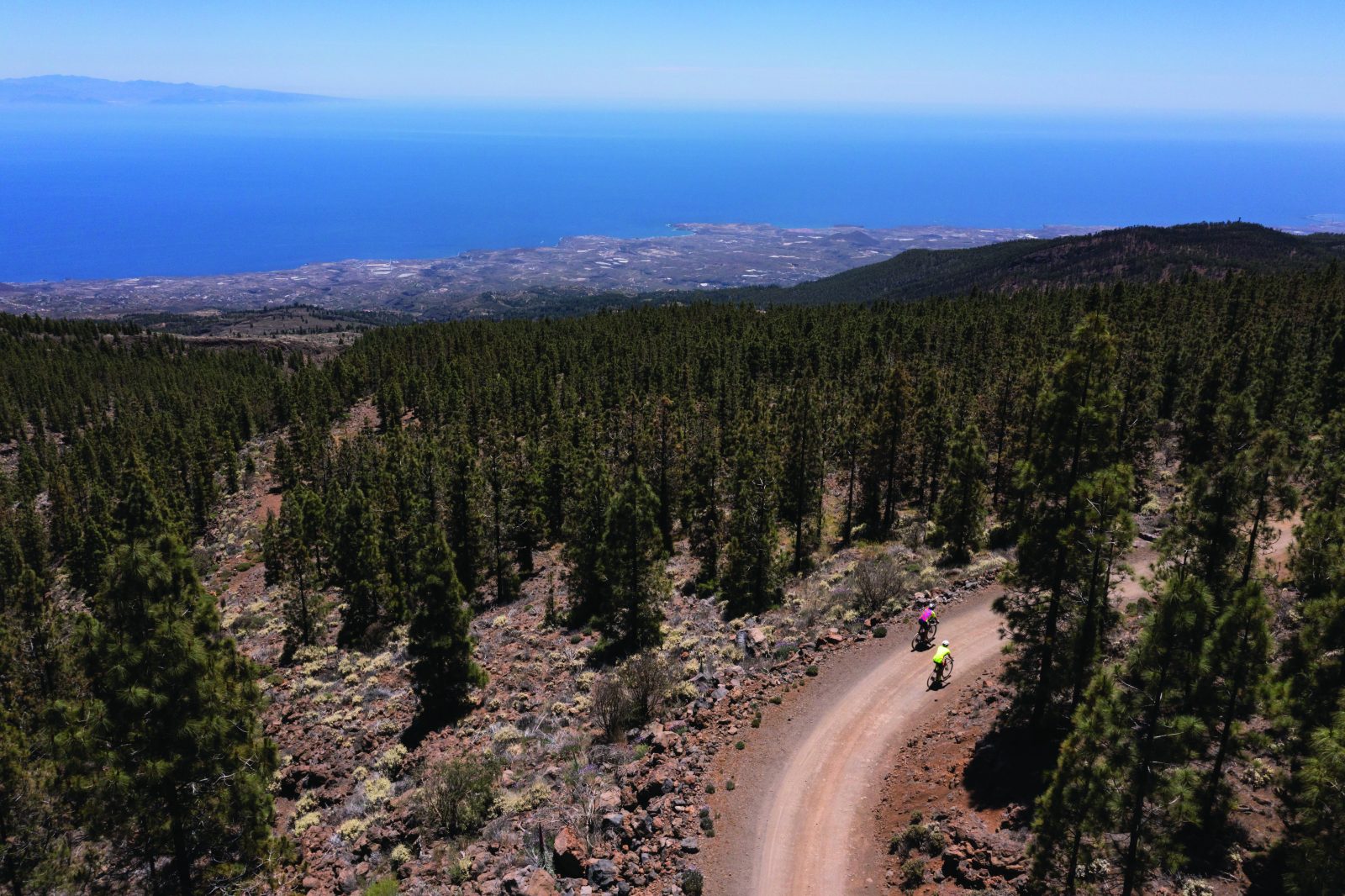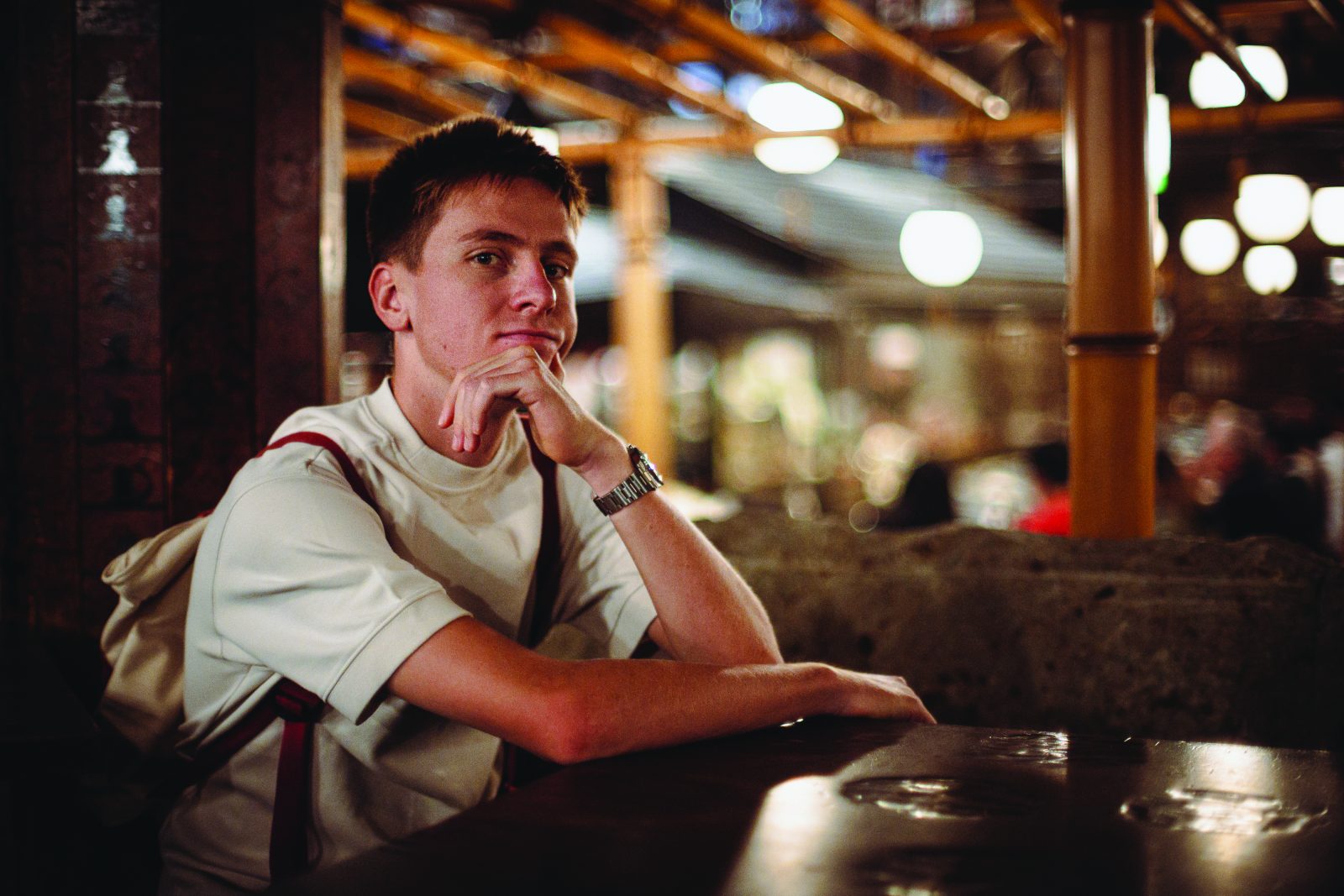Tenerife’s Mount Teide is amazing by road. It’s even more spectacular off-road.
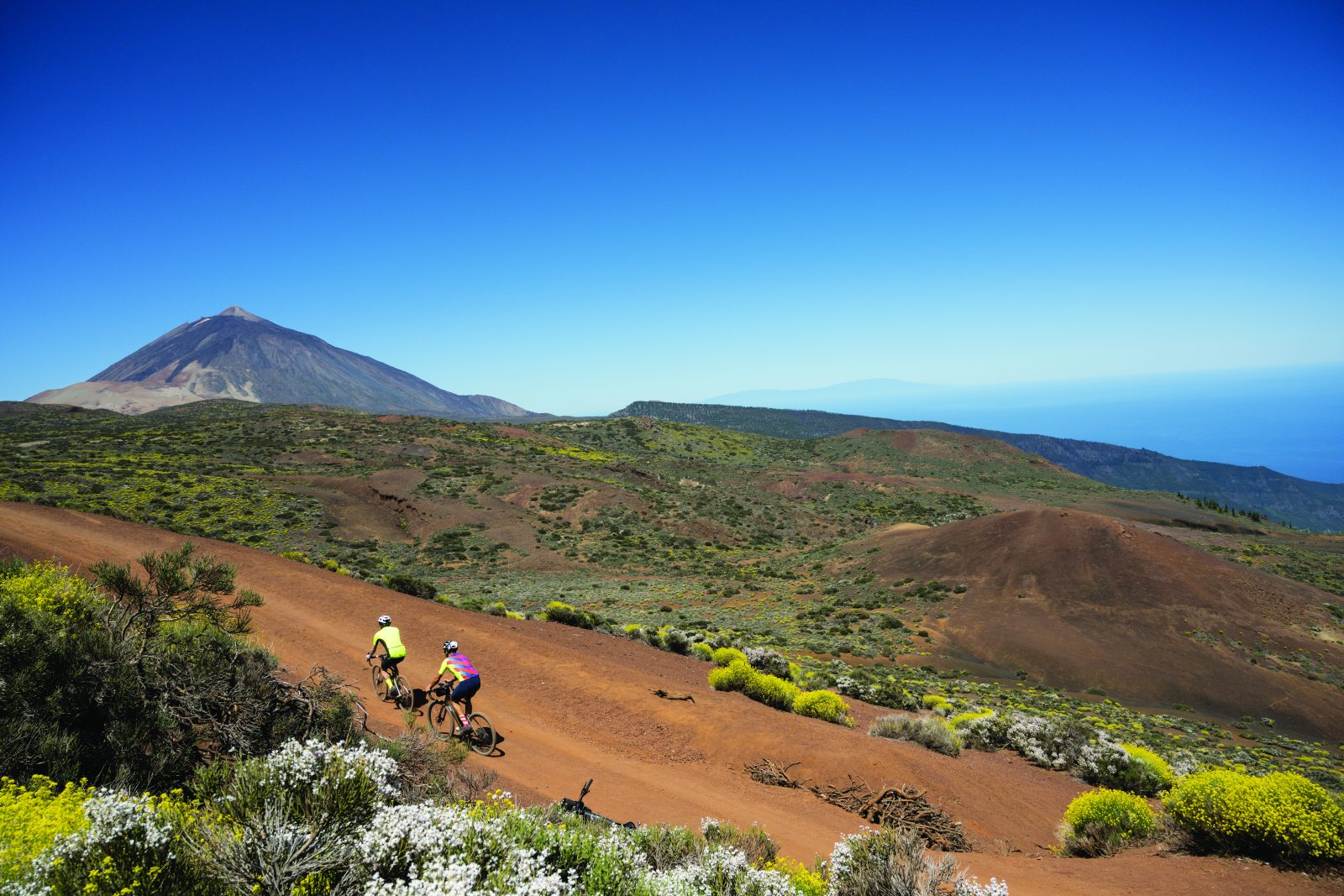
Words: Mark Bailey Photography: Patrik Lundin
The Ride
I ride past solidified rivers of lava and dark pine trees into a kaleidoscope of colour. My gravel tyres shimmy over blazing rust-red dirt and dust the shade of white-hot pumice. I pass strange, sea-green boulders and black orbs of rock that glisten like the island’s night skies. And all around me, the yellow flowers of Codeso del Pico and Teide Flixweed drench this alien world in a buttery glow.
Many cyclists visit Tenerife, but without gravel tyres, they will never get to see this remote, psychedelic dreamscape. Thanks to its volcanic geology and isolated geography, Tenerife is a laboratory for volcanologists, a museum for geologists, a pristine paradise for astronomers, a testing ground for NASA astronauts, and a film set for Hollywood movies. But the largest of the Canary Islands is also a 2,034km² playground for cyclists.
The island’s high altitudes, smooth roads and average temperature of 22°C make it a favourite training haven for pro teams as well as a winter escape for amateur riders. But Tenerife’s hidden gravel trails offer a gritty and more intimate way to explore the island, unlocking wild volcanic terrain and fresh cycling sensations.
On these bone-dry gravel trails I can feel the texture of the terrain shift beneath my tyres, taste the volcanic dust, smell the warm aroma of pine trees, see my skin slowly redden with dirt, and tune in to the silence of solitude. Six million visitors flock to Tenerife each year, but today I have seen only a few lizards scuttling among the rocks and a solitary rabbit. Far from the boozy bars, coach tours and sun-scorched beaches, a gravel rider can feel as though ‘Papa Teide’ – the name locals give to the island’s 3,715m volcano – has saved a corner of the island just for you.
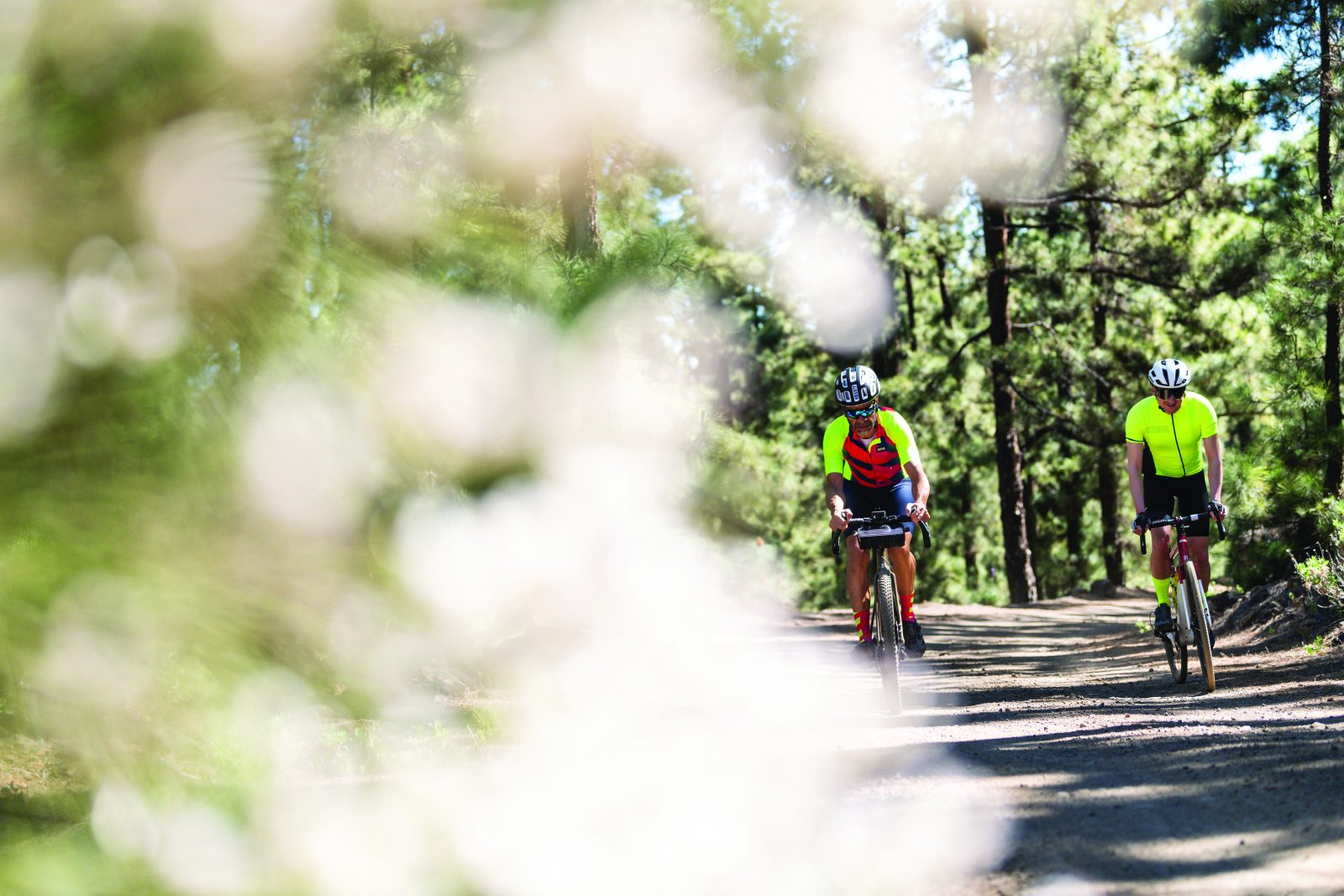
Park rangers
‘We are seeing a big interest in gravel cycling from road cyclists,’ says Alberto. ‘There are good gravel routes around the island, from the coast to the forests. Here in the Teide National Park, around the volcano, you can ride only one trail as most paths are protected. But it has everything: red sand, black rock, pine forests, and beautiful views of Teide.’
Alberto runs Tenerife Bike Training with his brother Marcos. Their local cycling knowledge has earned them an impressive reputation, and this is a proud family business: Mama Delgado hosts end-of-tour paella parties at the family home, where guests relax in their garden of avocado, orange, and apple trees. And when you’re heading off-road, local knowledge is invaluable.
Alberto calls today’s route ‘The Unseen National Park’ as it offers a new way to explore the 190km² Teide National Park. I’ve cycled in Tenerife before, but this is a journey into the unknown. As we prep our bikes, Alberto’s latest recruit Marco—a nutritionist—departs in the van and will meet us later on.
It’s possible to do this route unsupported, but doing so would add an extra 86km of road riding to come back round the mountain to arrive back at our start point, so on this occasion, I’m happy to not be a completist. For now, however, we are alone. Before we begin, Alberto gives me his customary warning: ‘The only flat part of Tenerife is the airport.’
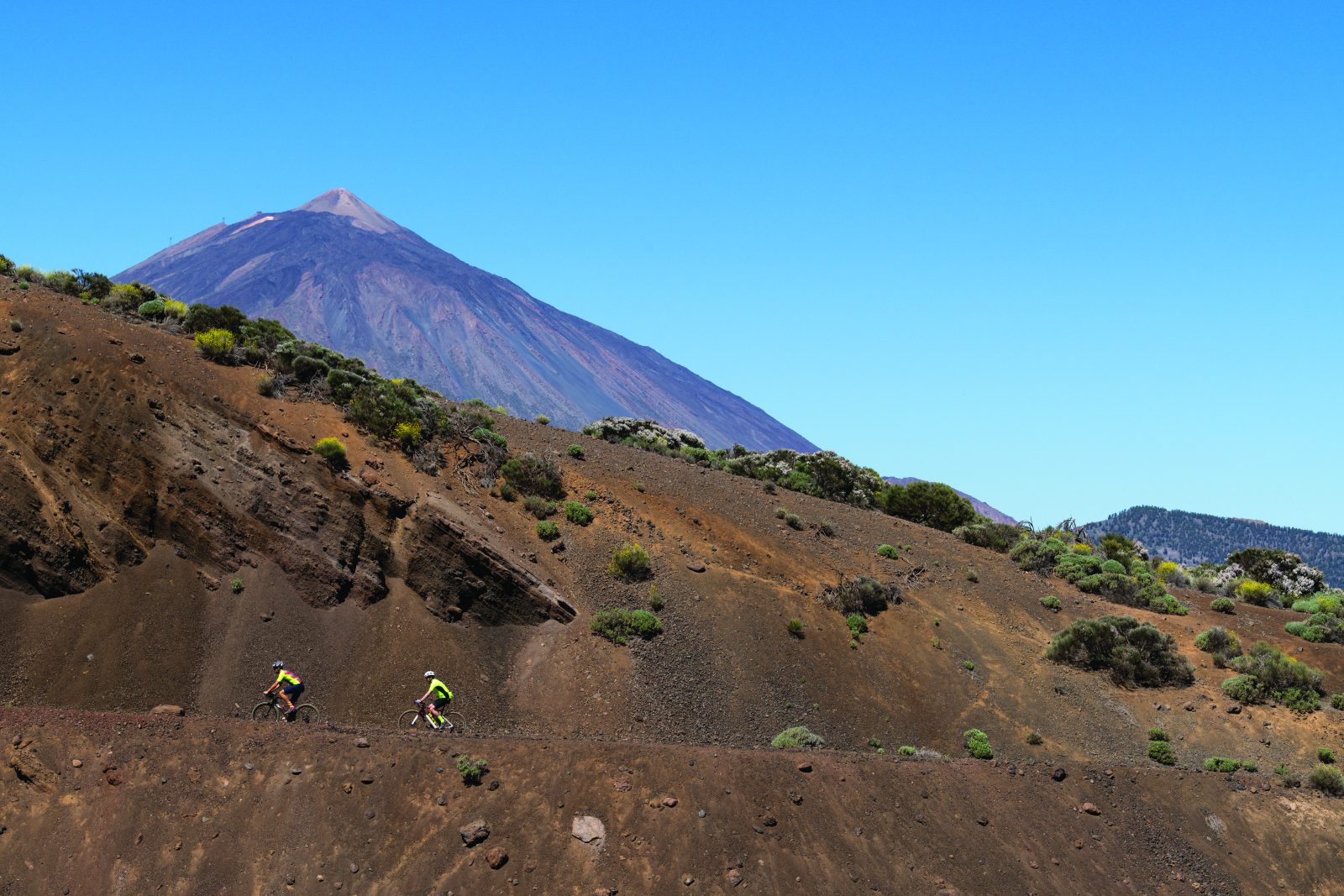
Sun, Sea, and Soil
Alberto leads the way, his technicolour kit providing a striking beacon of pink and yellow to follow. The grey-black track is tightly packed here, making for a smooth start. Caramel-coloured pinecones and feathery green needles carpet the floor, which seems to dance in the shifting shadows. It’s peaceful. I glimpse a woodpecker darting through the trees, but strange clusters of black and red boulders provide a reminder that we’re heading into sketchy volcanic terrain.
We emerge into a clearing and get our first glimpse of the dazzling expanse of the Atlantic below. In the northeast corner lies the port of Santa Cruz, where in 1797 Horatio Nelson lost his arm to a musket ball during a doomed mission to seize Spanish treasure ships.
The gravel trail continues uphill through scratchy scrubland and gnarled rock. In these high-altitude conditions, the shrubs are small and rounded to shelter from the wind and have small leaves to minimise water evaporation. Wind resistance and efficient hydration: two evolutionary skills any cyclist would respect.
As we ride past steep ledges, we can see the dense green carpet of forest below and the island of La Palma on the horizon. Then comes that spectacular sea of yellow Codeso del Pico and Teide Flixweed lighting up the red soil ahead.
The track uphill is an ever-changing conveyor belt of colours. The powdery red soil gobbles up my wheels, but the darker black and brown trails, the remnants of lava flows, are more solid. In Tenerife, a degree in geology would provide a unique cycling advantage.
Mount Teide looms into view, its cone speckled with the warm reds and browns of an English autumn. All day we have been cycling up the volcano’s northeastern flanks, climbing to a ridge that separates Valle de la Orotava and Valle de Guimar, but we’re now in the Teide National Park, a World Heritage Site of ethereal volcanic landscapes.
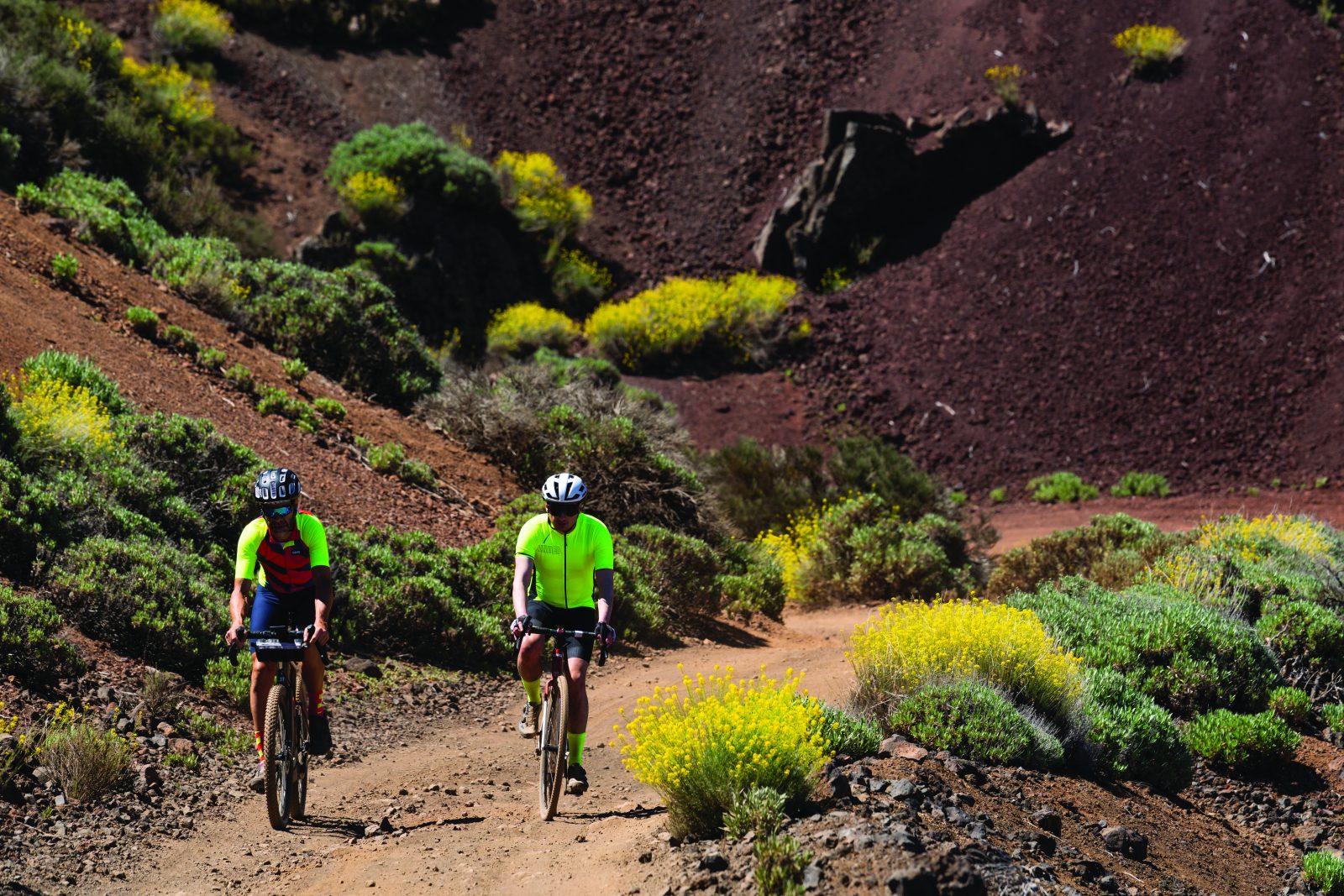
The heat is rising in this strange Martian landscape, and beads of sweat mix with the red sand on my legs. I’m feeling a little dazed when I glimpse a mysterious cluster of white structures resembling spaceships, missile silos, and pyramids. This is the Teide Observatory, the largest solar observatory in the world. It was at this observatory that scientists discovered that the sun has its own frequency and beats like a heart every five minutes.
The heat of the sun has got my heart beating as well. We continue uphill to the sunken cauldron of Las Cañadas, where we’re greeted by an array of ancient lava flows, ash cones, and rocky needles. This is also where the main road crosses the park. After a final steep push, we emerge onto the tarmac, and a road sign tells us we’ve reached 2,330m in altitude. We’ve ascended 740m, but with the heat, altitude, and uneven terrain, it feels like double that.
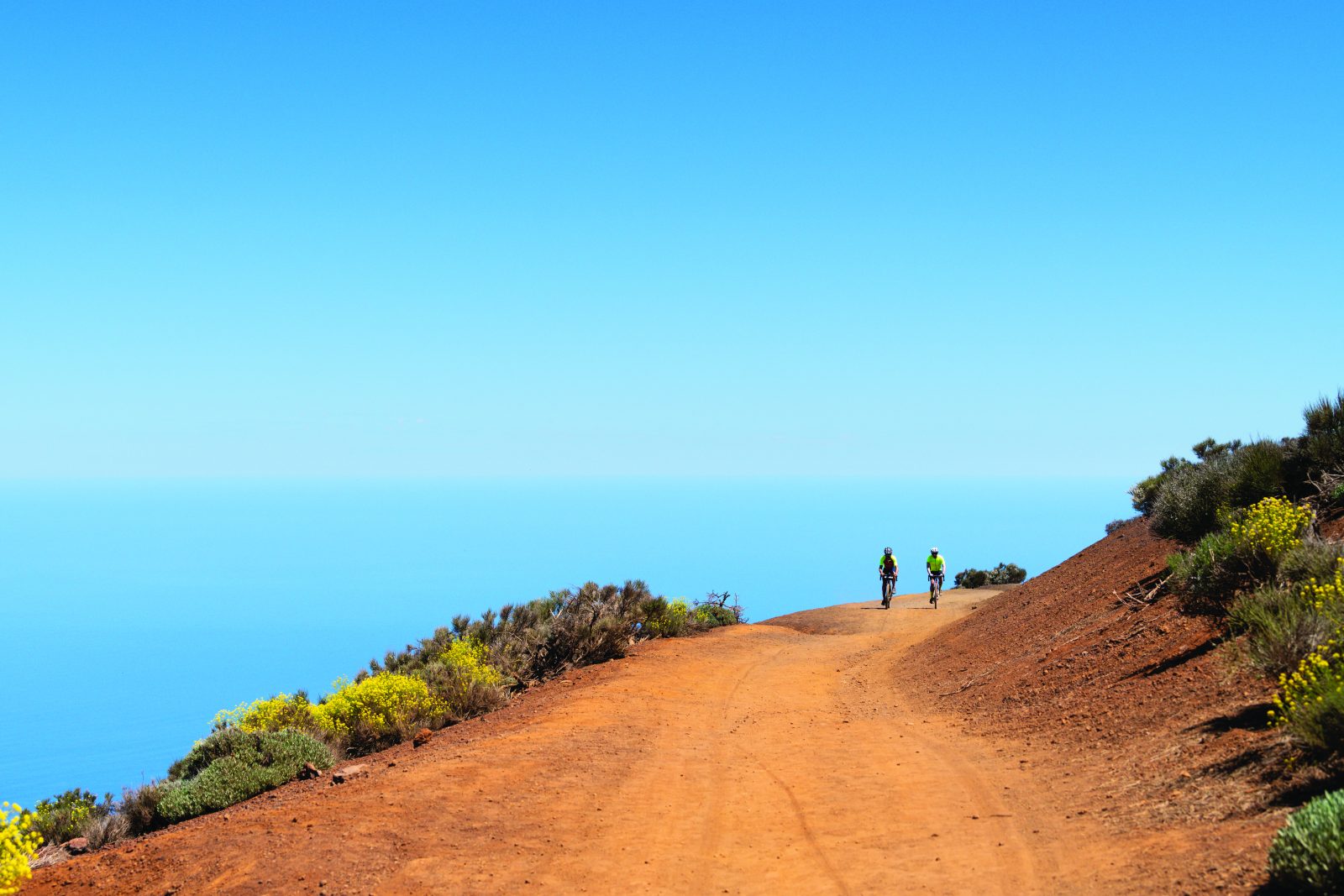
Into the Cauldron
After a short rest, we dart south, away from the tour buses, into the moonscape of the Las Cañadas cauldron. The red soil is so similar to that of Mars that NASA tested its Perseverance Rover here. This region has also provided locations for movies such as One Million Years BC, Wonder Woman 1984, and Clash of the Titans.
Bikes are forbidden off-road here, except on this track. The trail is wide and flat, and having climbed all morning, I find it refreshing to pick up speed. We pass mounds of black volcanic rocks piled up like giant coffee beans.
The track is a delight to descend, although some of the darker grey-black trails over jagged rocks do demand caution. Alberto glides gracefully around the corners, kicking up dust like a slalom skier. He is on 50mm tyres, which are proving to be better suited to the conditions than my 34mm rubber. Note to self: go bigger, have more fun.
At intervals, Alberto peels off to the side of the trail and tells me to carry on. At first, I wonder if he is having some mechanical issues, but then I realise he is stopping to pick up discarded gel wrappers that have been dropped by other cyclists. This is his home, and he wants it to be beautiful for his next guests too.
And what a home it is: we pass glistening obsidian rocks, the toffee-coloured trunks of Canarian pine trees, and the pink flowers of the Teide bugloss—a Tenerife postcard favourite. On and on we plunge along a thin ribbon of gravel track through the silent pine forest.
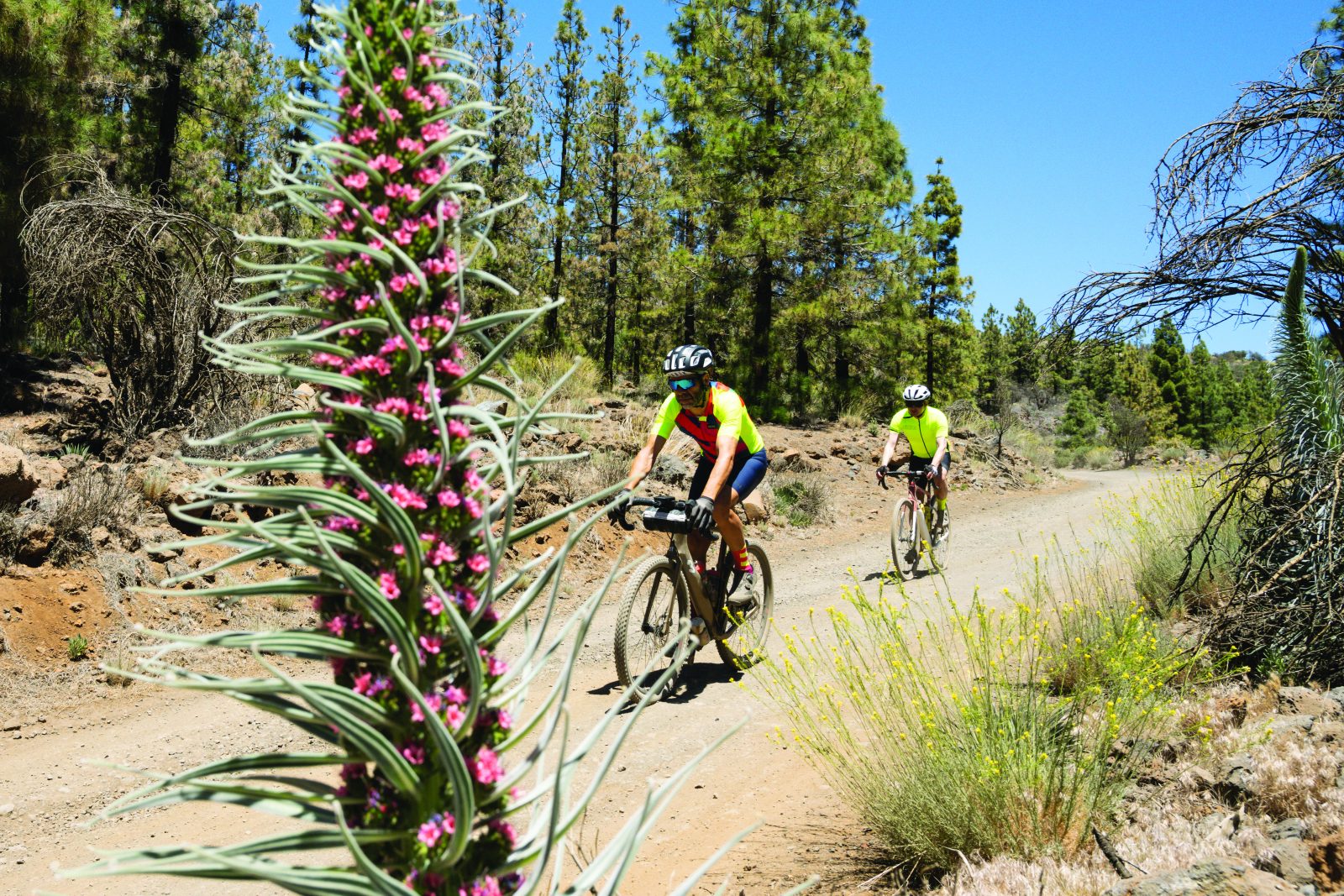
Despite the beauty, I force myself to remain on red alert. There are precipitous drops into ravines and plenty of sharp turns along the way. My hands are red from the braking, and my flesh is cooking in the afternoon heat, but the descent just keeps on unravelling, over gorges, past glistening walls of rock, with that gloriously cool blue ocean forever pulsing on the horizon.
We eventually join a roughly paved road where we pick up the pace towards Villa de Arico, a sleepy inland town of white-walled buildings. After our day of glorious solitude in extra-terrestrial landscapes, the sight of people and traffic is jarring, and it takes a moment to adjust. On returning to charted territory, I suddenly feel lost.
Marco is waiting for us in a café, and he has heroically ordered platters of white cheese, goat stew, croquettes, garbanzas (chickpea stew), and chips. We cool down in the shade and toast a glorious day of gravel riding. As I glug down an ice-cool glass of lemonade and stare at the red dust coating my legs, I’m secretly thankful that we don’t have to add on that extra 86km on the road to complete a full loop.
I’ve cycled in Tenerife many times, and it’s one of my favourite places to ride on the road, but Teide’s gravel trail has shown me another side to the island. I now understand why the ancient Greeks called this place ‘The Blessed Isle’. Plenty of people have cycled in Tenerife, but few have seen it like this.
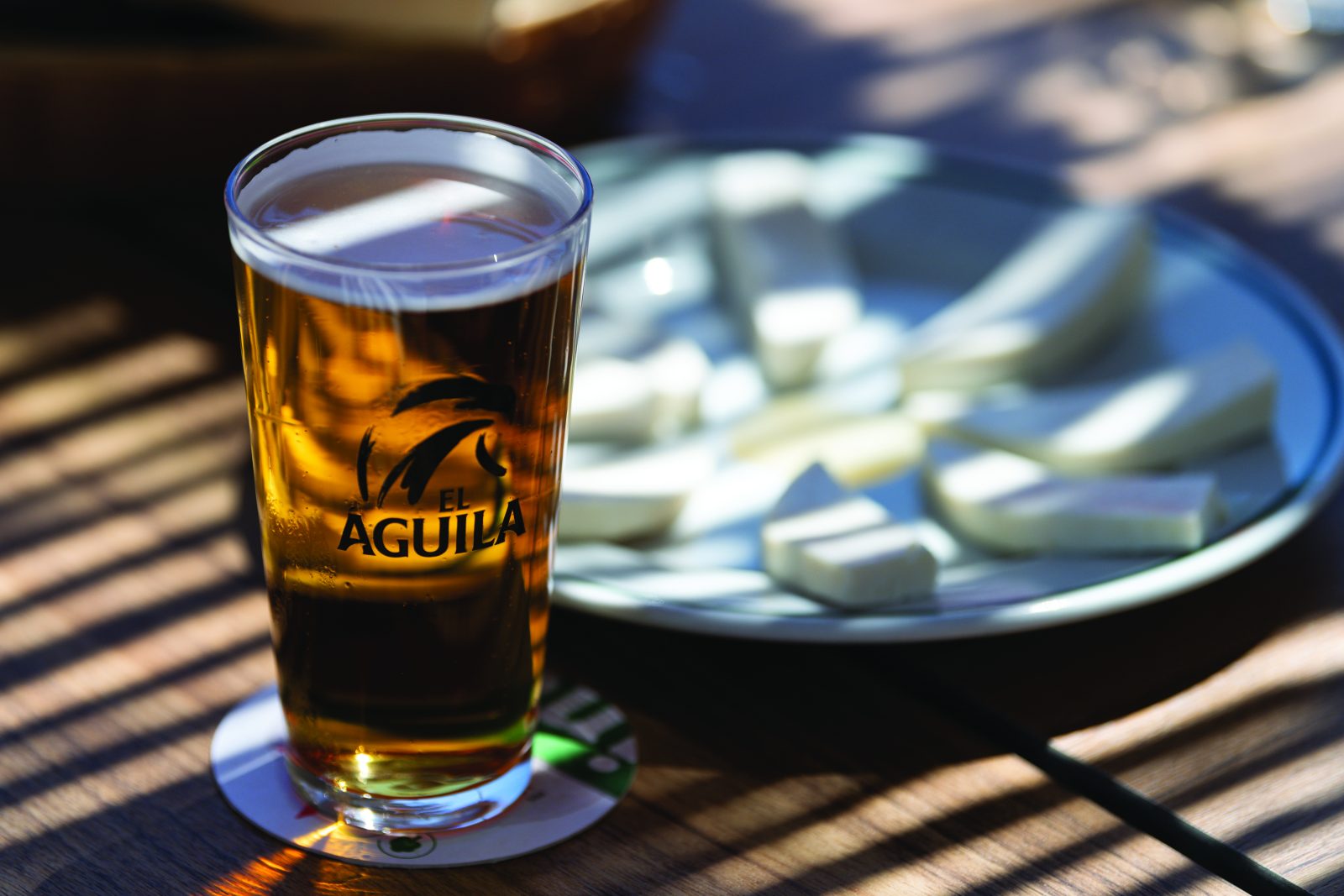
Coming round the mountain
To download this route go to komoot.com/tour/1427916801 or scan the QR code. This gravel route begins on the TF21 road at a picnic spot marked as Merenderos el Caramujoon Google Maps, about 21km south of La Orotava. If you don’t have vehicle support, you can start at La Orotava and ride along the TF21 to the start of the trail.
The trail climbs southwards on gravel until it reaches the TF24 road. After a brief stint on tarmac, the trail turns south again to cross Teide National Park to finish at Villa de Arico. If you need to return to La Orotava under your own steam, you can either head northeast on the TF28 and loop round the north of the island for 86km, or head south to Granadilla de Abona and climb Teide via the TF21 for an epic 148km loop.


By the numbers
Data is power
›46.2 Total distance in kilometres
›740 Total ascent in metres
›1,810 Total descent in metres
›2,350 Highest point in metres
›590 Lowest point in metres
›50 Optimum tyre width in millimetres
›1 Woodpeckers spotted
›0 Other cyclists spotted
How we did it
Travel: Reaching Gran Canaria from Australia is a bit of a mission, but a mission well worth it. You’ll be facing two stops no matter which way you cut it, but your main airlines to look at are British, Qatar, Emirates, and Iberia. La Orotava is about an hour’s drive from Tenerife’s south airport, or 20 minutes from the north airport.
Accommodation: Hotel Alua Tenerife (amrcollection.com) in the resort of Puerto de la Cruz, near to La Orotava, is a bike-friendly hotel with cycle storage, laundry services, a spa, and massage services.
Guiding: Local guides Alberto and Marcos Delgado of Tenerife Bike Training (tenerifebiketraining.com) offer various cycling trips around Tenerife, including a seven-night Gravel Tour with six off-road adventures, from volcanic terrain to coastal spins. Gravel tour prices start from €2,175 per person (about $3,600), which includes hotels and transfers.
Bike Hire: Bike Point Tenerife (bikepointtenerife.com) rents high-spec gravel bikes such as the 3T Explore, Pinarello Grevil GRX, and Pearl SL Evo from €29 (about $47) per day. Owners Christophe, Bjorn, and Romen know the island’s terrain and offer hotel delivery, bespoke fitting, and route information.
Information: For more about Tenerife, from cycling and hiking to food and days out, visit webtenerife.com.
